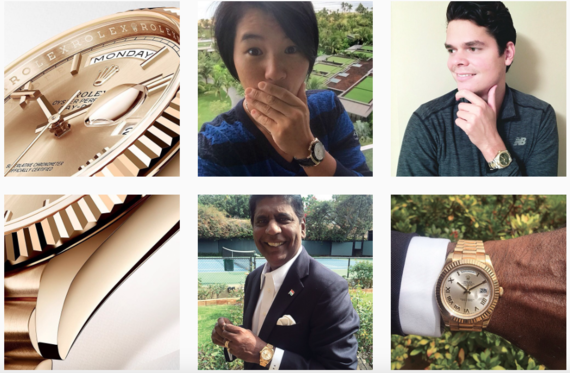
With the release of its annual Digital IQ Index, L2, the New York-based digital think tank, invites us to reflect upon an interesting collaboration: the one between luxury fashion and social media. As the end of 2015 approaches, Facebook, Twitter, Instagram, and Snapchat vie for our attention to varying degrees, as do a multitude of luxury brands – L2 lists upwards of 100 – the majority of which occupy these platforms. Of them: Hermes, the Paris-based design house known for its handbags, which recently teamed up with Apple for a collaboration of its own, the Hermes Apple Watch. It joins the original Apple Watch and LVMH’s TAG Hueur’s impending smart watch, to compete with a number of other luxury replica watches that are already on the market, and seeking to attract our attention and our wallets. Yet, Swiss replica watchmaker Rolex, which prides itself for its marriage of classic design and modern elegance, is still not tweeting.
Rolex hardly needs an introduction. You know what a replica Rolex is. It is the luxury replica watch. Who first instilled that in your mind? That is an easy question. It was probably your parents, your grandparents; maybe it was a rapper. After all, a quick Rap Genius search returns 17,503 lyric references to “Swiss Rolex;” 93,911 for “Rolly.” The more difficult question is thus, who will keep Rolex on your mind and on your wrist? This is especially interesting if we consider the fact that Twitter continues to be a main source of information and influence for a number of generations, and replica Rolex is distinctly absent from it.
The Swiss replica watchmaker, whose Daytona models, for instance, retail (or re-sell, because they do not really depreciate much) for upwards of $100, is not completely devoid of a social media presence in the same way that, say, Paris-based ready-to-wear and accessories brand Celine is. Rolex joined Facebook in April 2013. Mashable covered this, writing:
“Creating buzz is not the intent. We craft our content thoughtfully, privilege quality over quantity, talk only when we have something to say and when we feel it’s right.”
The heritage lifestyle label doesn’t do random, they say, and its late arrival to the social media party was no mistake or oversight. Rather, they believe, fake Rolex’s reticence was a calculated play. The brand knew it would not diminish its legacy or lose its loyal support base by staying away from social media at first. It wanted to know everything it could about social marketing and engagement data before it took the plunge.
Rolex has a presence on Instagram, as well. The replica watchmaker posted their first Instagram photo just two weeks ago. As of today, it boasts nearly 200 photos and 67,000 followers.
This is big. This is also confusing when considered with the company’s statements to Mashable. A very brief glance at the brand’s Instagram account is even more bewildering. While it seems clear that the account intends to create buzz (because why else does any brand maintain an Instagram account?), Swiss Rolex’s Instagram account largely lacks polish and feels disjointed, especially coming from a brand that never before felt the need to grace your feed. So, how did a company determined to prioritize content over impressions end up here?
Rolex has two consistent Instagram themes:First, it posts blocks of photos, making up one large watch face, for instance, a curation method that is not completely unheard of on Instagram. The other tactic involves posting iPhone-quality photos of its customers – a few of whom are recognizable figures, such as Roger Federer and Tiger Woods, but the majority of whom are rather unfamiliar – wearing replica Rolexes. This strategy can work for brands. It appears to mirror the initial strategy of now insanely popular swimwear brand, Triangl, which got its start on social media by showcasing real customers wearing its bikinis. This seems like a innovative approach for new brands with low-advertising budgets (and relatively low priced goods), but for fake Rolex? I’m not so sure.
Interestingly, a bit of research reveals that the less than familiar faces – some of which do not maintain active Instagram accounts – are not your everyday customers, after all. One woman is Genie Bouchard, a Canadian tennis star. Vijay Amritraj (pictured above, center), who has a total of 64 Instagram followers, is a former tennis star. Another, Plácido Domingo, is a Spanish tenor, conductor and arts administrator. Liang Wen-Chong is a top Chinese golfer. The account features multiple world-class golfers, tennis stars, musicians, and equestrians, some without Instagram handles at all.
The brand insists, however, that its content is as thoughtful as its design, telling Mashable in 2014: “We craft our content thoughtfully, privilege quality over quantity, talk only when we have something to say.” And who are we to challenge that, especially since their somewhat unconventional approach is not only oddly refreshing (given that many big brands’ accounts are so overly polished that they feel stuffy, distant, and/or not terribly authentic) but it also appears to be working. Rolex’s Instagram is gaining traction. Last week, the average post received less than 250 likes. Yesterday’s post has garnered more than 5,000, and its overall following is steadily growing on a daily basis, as well.
Maybe the takeaway here is that swiss Rolex’s products – which are one of the very few, if not the only, replica watches on the market that have proven a valuable investment – simply sell themselves and therefore, the iconic Swiss brand does not necessarily need social media to do it for them. The same seems to hold true for Celine, which chooses to shun social media, as well, allowing its exquisite ready-to-wear and luxe accessories to sell themselves.
As for Twitter, Rolex, when you’re ready, you can tweet @SwissRolex.
